
Footsteps of Paul & John
(Turkey and Greece)
Join Spirit & Truth on a
16 Day Tour & Cruise | April 26-May 11, 2024
Reservation Form (PDF) Online Reservation Insurance Info

Wholesale Tour Packages Since 1987 - Call Us Toll Free: 800.322.0788

Join Spirit & Truth on a
16 Day Tour & Cruise | April 26-May 11, 2024
| Date | Price | Single Supplement |
|---|---|---|
| April 26-May 11, 2024 | $4,659* Land Only: $3,409 |
$1,100 |
| *Includes airfare from New York City (JFK). Reservation Due: December 22, 2023 Final Payment Due: February 23, 2024 | ||
Included
Roundtrip air from New York City (JFK) including current air taxes and fuel surcharges (taxes and fuel charges are subject to change), 12 nights lodging at 4 star hotels, 2 nights on cruise ship in standard inside cabin, cruise port taxes and Patmos cruise excursion, breakfast and dinner daily, 2 lunches, full time English speaking tour escorts, services of air conditioned deluxe motor coach, all guides, entrances, touring and transportation as appears on itinerary, baggage handling at hotels (one piece), Whisper headsets, tips to driver, guides, hotel staff, and cruise staff
Not Included
12 lunches, Turkey Visa (currently $50 – must be purchased online), optional cruise shore excursions on Crete and Santorini (+$89 each), optional outside cabin on the cruise (+$180 or +$240 per person), optional travel insurance (7.95% or 10.85% of tour cost)
Day 1: Depart from USA
Today we embark on our journey to lands filled with ancient treasures and Christian history with an overnight flight to Turkey. Prepare yourself for a life-changing experience. Get some rest on the flight…tomorrow you will be walking where the apostles walked!
Day 2: Arrival, Bazaar, Spice Market
We transfer to our hotel in Istanbul for the night. Istanbul, the largest city in Turkey, is a thriving seaport and commerce center. If time allows, we will visit the marvelous Bazaar and Spice Market—a perfect opportunity to pick up those souvenirs and unique gifts.
Day 3: Hagia Sophia, Archaeological Museum, Sea of Marmara
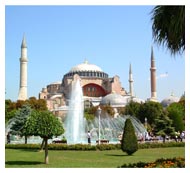
This morning, our guide will walk us through Hagia Sophia (Church of the Holy Wisdom), which was built in 537 AD by Byzantine emperor Justinian I. We will then peruse the incredible historical exhibits at the Istanbul Archaeological Museum. Treasures include the sarcophagus of Alexander the Great, mosaic remnants depicting the times of Nebuchadnezzar, tablets of the Treaty of Kadesh between Ramses II and the Hittites during the 13th century BC, and many other wonderful items. Next, departing Istanbul, we travel west across "Trace," the European portion of Turkey. The gorgeous summer homes along the Sea of Marmara will provide scenery as we travel, and views of the Dardanelles Strait may bring to mind the battle fought there and the major losses suffered by the Allied forces (especially British & French) in the famous World War I defeat. Finally, our bus boards a large ferry for the scenic crossing of the Dardanelles to our lodging this evening in picturesque Çanakkale.
Day 4: Alexandria Troas, Assos, Pergamum
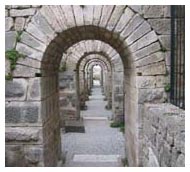
Today we visit the remains of Alexandria Troas, where Paul had a vision during his second missionary journey and was called to Macedonia (Acts 16:8-13). Paul later spent a week in Troas preaching, and Eutychus was resurrected from the dead (Acts 20:6-12). Our next visit of the day is Assos. During his third missionary journey the apostle Paul and his traveling companions visited Troas for several days. Paul wanted to stay in the city a few more hours to teach, so he sent his friends (which included Luke) ahead of him to Assos by boat. The sea journey was about 50 miles (80.5 km). Paul then journeyed on foot alone from Alexandria Troas to Assos to meet up with his companions (Acts 20:13-15). Our next site is Pergamum, once a busy trading center and famous as a "seller of purple." Pergamum was one of the Seven Churches in Revelation (Rev. 2:12-17), and it was here that the first Christians were executed by Rome. We'll visit the fabled Acropolis, pass through the Royal Gates, view the foundations of the Temple of Zeus, and visit the ruins of the library, which once held 200,000 volumes. Next, our journey continues south to Izmir, the third largest city in Turkey and a long-time center for Jews and Christians. Our lodging this evening will be in Izmir.
Day 5: Smyrna, Thyatira, Sardis, Philadelphia
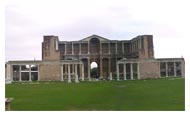
The first stop of the day is in Izmir at the agora of Smyrna, which was another of the Seven Churches (Rev. 2:8-11). Then, a stop will be made in Thyatira to view the ancient roadway and period columns before we head to Sardis. Sardis was berated by John for its facade of strength when in reality, it was weak (Rev. 3:1-6). Here, coins were minted, and the dyeing of wool originated. We’ll visit the remains of the large gymnasium and synagogue. Our next stop is the nearby ruins of Philadelphia, from where we are challenged to “hold fast” and look forward to the coming of the “new Jerusalem” (Rev. 3:7-13). Not much is left of the ancient city except for part of the wall and the remains of a Byzantine basilica in the modern city of Alaşehir. Our lodging this evening will be in a lovely spa hotel in Pamukkale.
Day 6: Hierapolis, Laodicea, Colossae
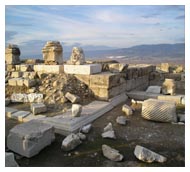
Our first stop is Hierapolis, meaning “Sacred City,” which was an ancient center for pagan cults until it was transformed into a Christian center in the first-century AD. According to tradition, the Apostle Philip lived and was martyred in Hierapolis. It was likely the hot springs of Hierapolis, in contrast to the cold mountain springs near Colossae, that combined to bring application to the “lukewarm” Laodiceans (Rev. 3:14-22). This connection between the cities is likely why Paul makes reference to both Hierapolis and Laodicea in his epistle to the Colossians (Col. 4:13). The next stop is Laodicea, which contains many acres of ruins to visit including a stadium and remnants of a sophisticated water system. A brief stop will be made at nearby Colossae, which is one of the privileged churches to receive a letter from the apostle Paul. The site is largely unexcavated, and thus not many ruins are visible. We spend the remainder of the day traveling through the Turkish countryside, arriving in the port city of Kuşadası, where we spend three nights. And the visit there will not be complete without a visit to a local Turkish Rug cooperative to see the world famous, hand-crafted Turkish rugs.
Day 7: Miletus, Didyma
Today we travel south to the ancient city of Miletus, where the apostle Paul gathered elders of the church of Ephesus and bade them farewell as recorded in (Acts 20:15–38). Known for its art, politics, and trade, Miletus was a principal port of the Ionian league. Today, we marvel at the impressive 15,000 seat theater, and the Faustina baths, which set a precedent for the development of the Turkish bath. Continuing on, we make a short trip south to Didyma, where we will set our eyes on the great Temple of Apollo, the third largest temple built by the Greeks and positioned around the site of a natural spring.
Day 8: Ephesus, Temple of Artemis
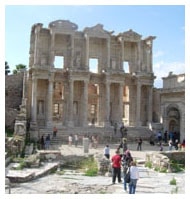
This morning, we visit Ephesus, one of the largest ancient city restorations still in progress with miles of archaeological treasures. Ephesus was once a thriving port town of 250,000 people. Today, you will walk down the main street of the ancient city where we will see many temples, the Library of Celsus, the Agora, the preserved artwork and colorful mosaics in the aristocratic Terrace Houses, and finally, the famous Ephesian amphitheater where a mob gathered after being stirred up by the silversmith, Demetrius, and they all began shouting for two hours, “Great is Artemis of the Ephesians!” (Acts 19:23-41). The theater offers a panoramic view of the city and the coast that now resides 3.7 miles away (6 km) on account of silting. For the remainder of the day, we visit the Temple of Artemis, completed in its most famous phase around 550 BC and listed as one of the Seven Wonders of the Ancient World. Today, only the foundation remains with a few columns.
Day 9: Isle of Patmos
This afternoon, we embark our cruise ship and sail for a visit to the beautiful Isle of Patmos, under statutory protection as a historic monument. Here we have an included tour to see the fortified monastery of St. John and the grotto (i.e., cave) traditionally claimed to be where John received the Revelation. Back on the ship, enjoy dinner before settling into your cabin for the night.
Day 10: Crete, Santorini
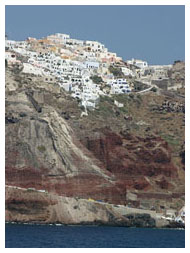
In the morning, we make port on the island of Crete, the largest and the most rugged of the Greek islands. You may take an optional tour to Heraklion and the fantastic ruins of the Palace of Knossos. Discovered in 1899 and partially reconstructed, the elaborate Palace is believed to be the mythical Labyrinth of King Minos and the seat of ancient Minoan culture. After returning to the cruise ship, we sail to the beautiful island of Santorini which is perhaps the most breathtaking of all the Greek islands. You may choose to take an optional panoramic bus tour viewing some of the most spectacular scenery of the Aegean. Travel through countless villages and settlements with delicate architecture and beauties, eventually arriving in Oia. During your time in Oia, visit the many narrow streets, open-air cafes, and glittering boutiques. Upon returning to the ship, we view the lace-like caldera, the little islands of Thirasia, Palea, & Nea Kameni. We arrive back at the ship in time for dinner and evening entertainment.
Day 11: Corinth & Cenchreae
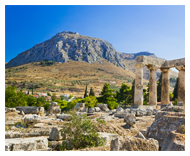
We disembark the cruise this morning at Athens and travel west to a rest stop for photos at the Corinth Canal. Next, we visit ancient Corinth, the metropolitan city of 800,000 where Paul founded a church that dealt with many troubles and to whom Paul wrote several letters. We will see the Archaeological Museum, the Agora, the Bema, and the Temples. The ruins of this important ancient center of Greek and Roman cultural are fascinating as we walk through the city where Paul spent a year and a half (Acts 1:11-12). The engineering skill and intellect of these people is evident in the water systems that still flow to this day. Our guide will be sure to show you the room of artifacts that were used for medical practices of that period. We travel on to the top of the nearby Acropolis overlooking Corinth and the place of the famous temple of Aphrodite where ancient sources describe there being a thousand temple servants, including both men and women. Another important stop is a visit to Diolkos, where we view the paved trackway which enabled boats to be moved overland across the Isthmus of Corinth, and which served as a lifeline for Corinth to access both the Aegean and Ionian Seas. This shortcut across the isthmus allowed ancient vessels to avoid the long and dangerous circumnavigation of the Peloponnese peninsula. Before returning to Athens for the evening, we will visit Cenchreae, the ancient port region of Corinth in the Saronic Gulf. This is where Paul landed during his second missionary journey and shaved his head on account of taking a vow (Acts 18:18).
Day 12: Athens
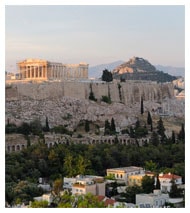
Following breakfast this morning, we tour Athens. We will visit the Acropolis and see the Parthenon, Erectheum, and the Theater of Dionysus. Then, from atop the Areopagus (Mars Hill) where Paul stood and preached the gospel to the Greek philosophers, we view the Agora below which we will visit later in the day. We then descend from the Acropolis to see the massive Temple of Zeus, one of the largest Greek temples, and Hadrian’s Arch. After loading back on the bus, we will enjoy a panoramic bus tour to view additional sites, such as the House of Parliament, the Tomb of the Unknown Soldier, Olympic Stadium, and the Presidential Palace.
Day 13: Delphi, Thermopylae, Meteora
This morning, we travel north and cross the Rion-Antirion Bridge, entering the lovely mountain region of Delphi, the ancient sanctuary of Apollo and the famous Oracle of Delphi. Here you will gain a greater understanding of the Greek religious heritage. We will also see the Gallio Inscription which has given scholars the one and only historical anchor point for all New Testament chronology. We will also visit the museum, where we will marvel at the site of the Charioteer, a bronze statue so delicately and intricately made that he even has eyelashes. From here we travel to the statue of Leonidas in Thermopylae, where the famous Spartan battle of “300” took place. Then, we continue on through the unique and fascinating mountains of central Greece. Our lodging this evening will be in Meteora.
Day 14: Meteora Monastery, Vergina, Berea, Thessalonica
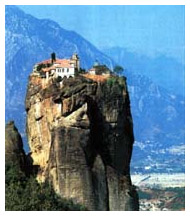
This morning, we enter one of the world-famous Byzantine monasteries perched precariously on summits of gray rock pinnacles of varied and beautiful shapes in the mountains near Meteora. Their history goes back to the 14th century when the monks sought refuge in the cliffside caves, then fled higher to build the original wooden shelters, later transformed into monasteries. Our next stop will be a visit to King Phillip's (Alexander the Great’s father) tomb in Vergina, one of the most outstanding archaeological finds in all of Greece. We then make the short trip to nearby Berea to view the site of the synagogue. The Bereans were noted as being “more noble than those in Thessalonica” because they were willing to examine Scripture to see if what Paul was preaching was, in fact, true (Acts 17:11). We also stop at the Bema surrounded by mosaics of Paul commemorating the church. We then travel on to the harbor city of Thessalonica, where Paul wrote two letters to the believers in the church. We spend two nights here.
Day 15: Lion Statue of Amphipolis, Philippi, Kavala, Via Egnatia, Thessalonica
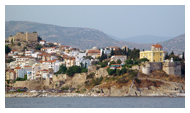
This morning we will make a brief stop in Amphipolis to view the famous lion statue, a tomb monument from the 4th century BC that Paul would have likely walked past on his way to Amphipolis. Next, we visit Philippi, where Paul preached his first evangelical sermon and baptized the first Christians on European soil. We will view the traditional baptismal site along the river, where Lydia surrendered her life to Christ, and we will visit a crypt dating from the Roman period that is thought to have possibly served as a prison for Paul when he was there. Next, we observe the famous Acropolis, the Market Place, Basilica, and the Theatre. On the way back, we stop for a brief overlook of the city of Kavala, which is the ancient city of Neapolis where Paul landed after sailing across the Aegean Sea with his disciples, Timothy and Silas, to Macedonia after receiving the vision in Alexandria Troas. Neopolis was later renamed Christoupolis because it was the first European city to accept Christianity, but then in the 5th century AD it was renamed Kavala. Kavala is Greece's prettiest mainland port with a most elegant harbor. Just outside Kavala, we will walk along the ancient Via Egnatia, which is the actual path that Paul walked when he arrived in Macedonia. We will be walking the very same steps as the apostle Paul over two thousand years ago! We return to Thessalonica and head to the Roman Forum, followed by the Arch of Galerius. From here we head to the Heptaprygion (citadel) on the city acropolis to get a look at the massive Byzantine walls before returning to the hotel for the night.
Day 16: Homeward Bound
We transfer to the airport at Thessaloniki for our flight home.
Itinerary subject to change while touring for the best interest of the group.